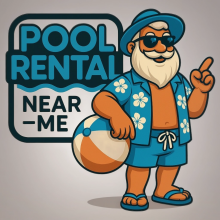Insurance and Liability Basics - PoolRentalNearMe.com
Essential Guide to Pool Insurance Coverage and Liability Protection
Understanding insurance and liability is crucial for pool owners, operators, and rental properties. This guide covers the fundamental aspects of pool-related insurance coverage and liability management.
Types of Pool Insurance Coverage
Homeowner's Insurance and Pools
Standard Coverage Limitations:
TYPICAL HOMEOWNER'S POLICY:
□ Pool structure coverage (usually included)
□ Equipment coverage (pumps, filters, heaters)
□ Liability coverage (varies by policy)
□ Medical payments (limited amounts)
□ Property damage protection
COMMON EXCLUSIONS:
□ Commercial pool operations
□ Rental property pools (may need separate policy)
□ Diving board and slide accidents
□ Pools without proper barriers/fencing
□ Unattended pool access incidents
□ Pool maintenance-related damages
COVERAGE GAPS TO ADDRESS:
□ Insufficient liability limits
□ Lack of umbrella coverage
□ Missing rental property endorsements
□ Inadequate medical payment limits
□ No coverage for pool business operations
Commercial Pool Insurance
Business Insurance Requirements:
GENERAL LIABILITY INSURANCE:
□ Minimum $1-2 million per occurrence
□ $2-4 million aggregate coverage
□ Product liability protection
□ Professional liability coverage
□ Premises liability protection
PROPERTY INSURANCE:
□ Pool structure and equipment
□ Business personal property
□ Loss of income coverage
□ Equipment breakdown protection
□ Ordinance and law coverage
SPECIALIZED COVERAGE:
□ Aquatic facility liability
□ Lifeguard professional liability
□ Pool management errors & omissions
□ Cyber liability for booking systems
□ Workers' compensation (if employees)
Umbrella Insurance Policies
Additional Liability Protection:
UMBRELLA POLICY BENEFITS:
□ Higher liability limits ($1-5 million+)
□ Broader coverage than underlying policies
□ Protection against catastrophic claims
□ Coverage for legal defense costs
□ Worldwide liability protection
COST-EFFECTIVE PROTECTION:
□ Relatively inexpensive premium
□ Significant increase in coverage limits
□ Peace of mind for high-risk activities
□ Protection of personal assets
□ Business continuity assurance
UMBRELLA POLICY REQUIREMENTS:
□ Underlying liability insurance minimums
□ Auto insurance requirements
□ Property insurance standards
□ Risk management compliance
□ Safety protocol implementation
Common Liability Scenarios
Drowning and Water-Related Incidents
High-Risk Liability Situations:
DROWNING INCIDENTS:
Potential Damages: $500,000 - $10+ million
Common Causes:
□ Inadequate supervision
□ Missing or faulty safety equipment
□ Poor pool maintenance
□ Lack of barriers or fencing
□ Inadequate warning signs
NEAR-DROWNING INCIDENTS:
Potential Damages: $100,000 - $5 million
Long-term Consequences:
□ Brain injury and disability
□ Ongoing medical expenses
□ Lost wages and earning capacity
□ Pain and suffering damages
□ Family care and support costs
PREVENTION STRATEGIES:
□ Proper safety equipment maintenance
□ Adequate supervision protocols
□ Clear safety rules and signage
□ Regular safety training
□ Emergency response procedures
Slip and Fall Accidents
Pool Deck and Area Hazards:
COMMON SLIP/FALL SCENARIOS:
□ Wet pool deck surfaces
□ Inadequate lighting around pool
□ Broken or uneven deck surfaces
□ Missing or inadequate handrails
□ Poolside furniture and obstacles
□ Chemical spills and residue
TYPICAL INJURY CLAIMS:
□ Broken bones and fractures
□ Head and brain injuries
□ Spinal cord injuries
□ Cuts and lacerations
□ Soft tissue injuries
AVERAGE SETTLEMENT RANGES:
Minor injuries: $5,000 - $25,000
Moderate injuries: $25,000 - $100,000
Severe injuries: $100,000 - $1 million+
Permanent disability: $1 million+
LIABILITY REDUCTION MEASURES:
□ Non-slip surface materials
□ Adequate lighting installation
□ Regular maintenance and inspection
□ Prompt hazard removal
□ Warning signs for wet areas
Equipment-Related Injuries
Pool Equipment Hazards:
EQUIPMENT LIABILITY RISKS:
□ Pool drain entrapment
□ Chemical burns and exposure
□ Electrical shock hazards
□ Diving board/slide injuries
□ Pool cover entanglement
□ Filtration system failures
DRAIN ENTRAPMENT PREVENTION:
□ VGB-compliant drain covers
□ Multiple drain systems
□ Safety vacuum release systems
□ Regular inspection and maintenance
□ Clear warning signage
CHEMICAL SAFETY MEASURES:
□ Proper chemical storage
□ Automated chemical systems
□ Safety data sheets available
□ Staff training on chemical handling
□ Emergency response procedures
Liability Protection Strategies
Risk Management Practices
Proactive Liability Reduction:
SAFETY PROTOCOLS:
□ Written safety rules and procedures
□ Regular safety equipment inspections
□ Staff training and certification
□ Emergency response plans
□ Incident documentation procedures
PHYSICAL SAFETY MEASURES:
□ Proper fencing and barriers (4+ feet high)
□ Self-closing, self-latching gates
□ Pool covers and alarms
□ Safety equipment readily available
□ Adequate lighting and visibility
SUPERVISION REQUIREMENTS:
□ Certified lifeguards when required
□ Adult supervision policies
□ Swim ability assessments
□ Capacity limits and enforcement
□ Emergency contact information
DOCUMENTATION PRACTICES:
□ Daily safety checklists
□ Maintenance logs and records
□ Training certificates and renewals
□ Incident reports and investigations
□ Insurance policy reviews
Legal Documentation
Essential Legal Protections:
LIABILITY WAIVERS:
□ Properly drafted waiver language
□ State-specific legal requirements
□ Clear assumption of risk statements
□ Parental consent for minors
□ Regular legal review and updates
RENTAL AGREEMENTS:
□ Clear safety rule requirements
□ Supervision responsibilities
□ Equipment use restrictions
□ Emergency contact requirements
□ Insurance and indemnification clauses
SAFETY SIGNAGE:
□ "No Diving" signs in shallow areas
□ Pool rules and regulations posted
□ Emergency contact information
□ Chemical safety warnings
□ Capacity and age restrictions
STAFF POLICIES:
□ Hiring and background checks
□ Training requirements and documentation
□ Supervision and accountability measures
□ Emergency response procedures
□ Incident reporting protocols
Insurance Claims Process
Immediate Response Steps
When an Incident Occurs:
IMMEDIATE ACTIONS (First 24 Hours):
□ Ensure victim receives medical attention
□ Secure the accident scene
□ Document everything with photos/video
□ Collect witness contact information
□ Notify insurance company immediately
□ Contact legal counsel if serious injury
DO NOT:
□ Admit fault or liability
□ Discuss insurance coverage limits
□ Make settlement offers
□ Destroy or alter evidence
□ Discuss incident on social media
□ Provide recorded statements without counsel
DOCUMENTATION REQUIREMENTS:
□ Incident report with detailed facts
□ Photos of scene and conditions
□ Witness statements and contact info
□ Medical reports and treatment records
□ Maintenance and inspection logs
□ Safety equipment condition reports
Working with Insurance Companies
Claims Management Best Practices:
INSURANCE COMPANY COOPERATION:
□ Report claims promptly (within 24-48 hours)
□ Provide complete and accurate information
□ Cooperate with investigation requests
□ Maintain detailed records and communication
□ Follow company procedures and requirements
CLAIM INVESTIGATION PROCESS:
□ Insurance adjuster assignment
□ Scene investigation and evidence collection
□ Witness interviews and statements
□ Expert evaluation and analysis
□ Medical record review and evaluation
□ Settlement negotiation or litigation
YOUR RIGHTS AND RESPONSIBILITIES:
□ Right to legal representation
□ Duty to cooperate in good faith
□ Right to dispute coverage decisions
□ Responsibility for timely reporting
□ Right to participate in settlement decisions
Cost Management and Budgeting
Insurance Premium Factors
Factors Affecting Insurance Costs:
RISK FACTORS THAT INCREASE PREMIUMS:
□ Pool size and depth
□ Diving boards and slides
□ Commercial vs. residential use
□ Number of users/capacity
□ Location and local claim history
□ Safety equipment and protocols
□ Staff training and certification levels
PREMIUM REDUCTION STRATEGIES:
□ Implement comprehensive safety programs
□ Install additional safety equipment
□ Increase staff training and certification
□ Maintain excellent safety records
□ Install security and monitoring systems
□ Work with specialized pool insurers
□ Bundle coverage with other policies
TYPICAL ANNUAL PREMIUM RANGES:
Residential Pool: $200 - $800/year
Small Commercial: $2,000 - $8,000/year
Large Facility: $10,000 - $50,000+/year
Rental Property: $500 - $2,500/year
*Premiums vary significantly based on coverage limits,
location, and risk factors
Budget Planning for Insurance
Annual Insurance Budget:
INSURANCE BUDGET COMPONENTS:
□ General liability premiums
□ Property insurance costs
□ Umbrella policy premiums
□ Workers' compensation (if applicable)
□ Legal and professional fees
□ Risk management program costs
SAMPLE ANNUAL BUDGET (Small Commercial Pool):
General Liability: $3,500
Property Insurance: $1,200
Umbrella Policy: $800
Risk Management: $500
Legal/Professional: $300
Total Annual Cost: $6,300
BUDGET OPTIMIZATION STRATEGIES:
□ Shop multiple insurance providers
□ Review coverage annually
□ Implement loss control measures
□ Consider higher deductibles
□ Bundle policies for discounts
□ Maintain good claims history
Legal Compliance Requirements
State and Local Regulations
Regulatory Compliance:
COMMON LEGAL REQUIREMENTS:
□ Minimum insurance coverage limits
□ Safety equipment standards
□ Fencing and barrier requirements
□ Lifeguard certification mandates
□ Health department regulations
□ Building and zoning compliance
DOCUMENTATION REQUIREMENTS:
□ Insurance certificates and policies
□ Safety inspection reports
□ Staff training and certification records
□ Maintenance and repair logs
□ Incident reports and investigations
□ Regulatory compliance documentation
PENALTY RISKS FOR NON-COMPLIANCE:
□ Fines and regulatory sanctions
□ License suspension or revocation
□ Increased insurance premiums
□ Voided insurance coverage
□ Personal liability exposure
□ Criminal liability in severe cases
Emergency Contact Information
Insurance and Legal Resources
INSURANCE CONTACTS:
Primary Insurance Agent: ________________
Phone: ________________________________
Policy Number: _________________________
24/7 Claims Hotline: ____________________
Umbrella Policy Provider: ________________
Phone: ________________________________
Policy Number: _________________________
LEGAL CONTACTS:
Pool/Premises Liability Attorney: __________
Phone: ________________________________
Emergency Legal Hotline: ________________
Risk Management Consultant: _____________
Phone: ________________________________
REGULATORY CONTACTS:
Local Health Department: ________________
Phone: ________________________________
State Insurance Commissioner: ____________
Phone: ________________________________
Quick Reference Checklist
Monthly Insurance Review
MONTHLY TASKS:
□ Review insurance policy status
□ Update coverage for any changes
□ Document safety improvements
□ Review incident reports
□ Update emergency contacts
□ Check staff certification status
QUARTERLY TASKS:
□ Meet with insurance agent
□ Review claims history
□ Assess coverage adequacy
□ Update risk management practices
□ Review legal compliance status
□ Plan for upcoming renewals
ANNUAL TASKS:
□ Comprehensive policy review
□ Shop for competitive rates
□ Update property valuations
□ Review liability limits
□ Assess new risk exposures
□ Plan insurance budget for next year
Remember: Insurance and liability management are complex areas requiring professional guidance. Consult with qualified insurance agents, attorneys, and risk management professionals to ensure adequate protection for your specific situation.
For additional insurance resources and professional referrals, visit: poolrentalnearme.com/insurance-resources

